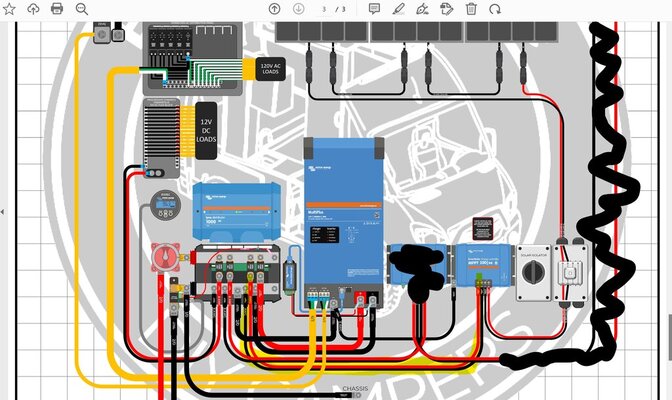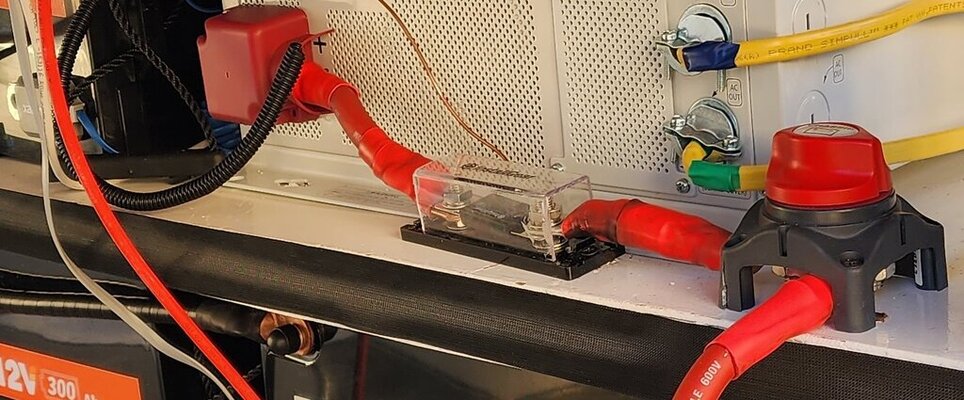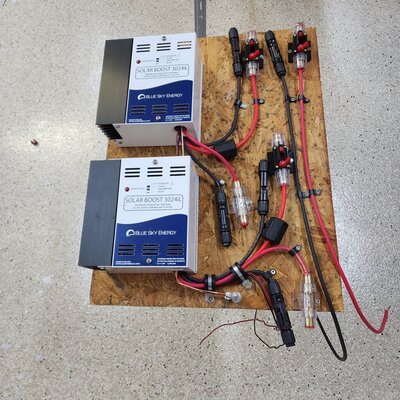You are using an out of date browser. It may not display this or other websites correctly.
You should upgrade or use an alternative browser.
You should upgrade or use an alternative browser.
Fuse confusion, what size is needed?
- Thread starter chaostactics
- Start date
The friendliest place on the web for anyone with an RV or an interest in RVing!
If you have answers, please help by responding to the unanswered posts.
If you have answers, please help by responding to the unanswered posts.
Mark_K5LXP
Well-known member
Generally you fuse for the wire gauge. You can go less from there if you want. After that the fuse has to be rated for the voltage.
Mark B.
Albuquerque, NM
Mark B.
Albuquerque, NM
HueyPilotVN
Well-known member
You need to show a little more detail.
It looks like your battery bank is not shown and is located below the schematic where the shunt on the negative black line and the disconnect is shown by the red heavy line.
You will want a catastropic fuse either before or after the disconnect by the invertor and an inline fuse or circuit breaker that may already be shown next to the solar disconnect and maybe another at the output from your charge controller.
We need detail on the size of your battery bank and the rating of your invertor to calculate your draw from the batteries in amps. It should be specified in your invertor documentation.
The size of your controller inline fuses before and after the controller are based on the amps thru the combined feed from your panels.
It looks like your battery bank is not shown and is located below the schematic where the shunt on the negative black line and the disconnect is shown by the red heavy line.
You will want a catastropic fuse either before or after the disconnect by the invertor and an inline fuse or circuit breaker that may already be shown next to the solar disconnect and maybe another at the output from your charge controller.
We need detail on the size of your battery bank and the rating of your invertor to calculate your draw from the batteries in amps. It should be specified in your invertor documentation.
The size of your controller inline fuses before and after the controller are based on the amps thru the combined feed from your panels.
Attachments
Last edited:
Gary RV_Wizard
Site Team
I don't know what to make of that diagram, but Mark has given the definitive answer. The fuse rating should never exceed the wire amp capacity, which is primarily limited by the wire diameter (gauge). You can go with a lower amp rating if you are confident the combined amp loads on the circuit are smaller, but that is at your option. In simplistic terms, the fuse protects the wire, not the devices on the circuit.
chaostactics
Well-known member
You need to show a little more detail.
It looks like your battery bank is not shown and is located below the schematic where the shunt on the negative black line and the disconnect is shown by the red heavy line is.
You will want a catastropic fuse either before or after the disconnect by the invertor and a inline fuse that maybe shown next to the solar disconnect and maybe another at the output from your charge controller.
We need detail on the size of your battery bank and the rating of your invertor to calculate you draw from the batteries in amps. It should be specified in your invertor documentation.
The size of your controller inline fuses before and after the controller are based on the amps thru the combined feed from the panels in series,
I just need the fuse rating between the MPPT and Lynx bus bar. I have all the other fuse values. To answer your questions generally.
600 watts of solar in parallel, to a 100|50 MPPT, to a LYNX Power in 1000 busbar, a single 300 Ah battery, the inverter is the MultiPlus C 12/2000/80-50 120V
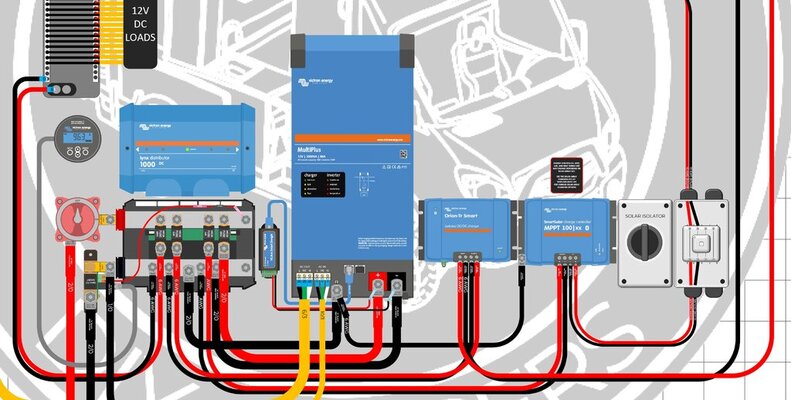
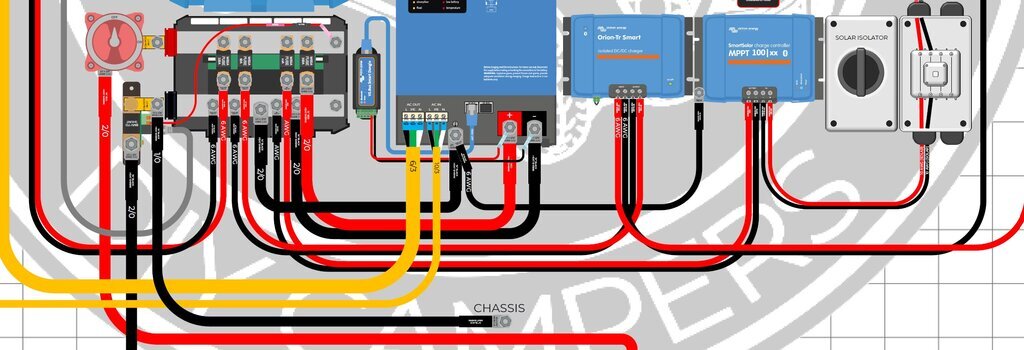
chaostactics
Well-known member
I'm seeing anywhere between 32-75 amps in my searches for allowable amperage for 6 gauge.I don't know what to make of that diagram, but Mark has given the definitive answer. The fuse rating should never exceed the wire amp capacity, which is primarily limited by the wire diameter (gauge). You can go with a lower amp rating if you are confident the combined amp loads on the circuit are smaller, but that is at your option. In simplistic terms, the fuse protects the wire, not the devices on the circuit.
The Victron 100|50 is rated for a charge current of 50 Amps. So then 50 amp fuse?
chaostactics
Well-known member
I'm seeing anywhere between 32-75 amps in my searches for allowable amperage for 6 gauge. The median number seems to be 55 amps. My wire length is going to be less than 2 feet, hopefully less than a foot.Generally you fuse for the wire gauge. You can go less from there if you want. After that the fuse has to be rated for the voltage.
Mark B.
Albuquerque, NM
The Victron 100|50 is rated for a charge current of 50 Amps. So then 50 amp fuse?
HueyPilotVN
Well-known member
I would recommend a 60 amp inline fuse from the controller to the bus bar.
You could use a 50 amp but you might end up changing it often.
Back to the battery to invertor issue. You might be surprised at how much the invertor under load can draw. A cat fuse at the output from the battery to the invertor is a good idea. Check your invertor documentation for the value. I am sure that the wire size from the battery is much larger than 6 guage.
Your buss bar might have a fuse but I do not see it or maybe it is located by the battery bank and not shown in the schematic.
I used 1/0 battery cables on my system.
You could use a 50 amp but you might end up changing it often.
Back to the battery to invertor issue. You might be surprised at how much the invertor under load can draw. A cat fuse at the output from the battery to the invertor is a good idea. Check your invertor documentation for the value. I am sure that the wire size from the battery is much larger than 6 guage.
Your buss bar might have a fuse but I do not see it or maybe it is located by the battery bank and not shown in the schematic.
I used 1/0 battery cables on my system.
Last edited:
Mark_K5LXP
Well-known member
chaostactics
Well-known member
The battery has a 300 amp ANL fuse inline with the positive line. the batteries are 2/0 as is the line from the Lynx to the inverterI would recommend a 60 amp inline fuse from the controller to the bus bar.
You could use a 50 amp but you might end up changing it often.
Back to the battery to invertor issue. You might be surprised at how much the invertor under load can draw. A cat fuse at the output from the battery to the invertor is a good idea. Check your invertor documentation for the value. I am sure that the wire size from the battery is much larger than 6 guage.
Your buss bar might have a fuse but I do not see it or maybe it is located by the battery bank and not shown in the schematic.
I used 1/0 battery cables on my system.
chaostactics
Well-known member
Super helpful thank you!
Is there any reason I should not just go to the 70A fuse? especially since I'm going to have a short run from the controller tro the lynx. I think I can have it be under a foot line. Amp carrying capacity is gauge + length?
Last edited:
HueyPilotVN
Well-known member
Good, glad to hear that you have it covered.
CharlesinGA
Well-known member
For a supply from a Lithium battery, an ANL fuse is not suitable. It has to do with interrupt ratings. The best explanation is to read this thread on the Escape trailer Forum, started by TDF-Texas.The battery has a 300 amp ANL fuse inline with the positive line. the batteries are 2/0 as is the line from the Lynx to the inverter
Battery current interrupt fuses - Escape Trailer Owners Community
Post #4 gives the details.
Charles
chaostactics
Well-known member
Turns out 70 amp mega fuses don't really exist so I'm trying to figure out... 60 or 80
Latest posts
-
-
-
-
-
-
-
-
-
New and looking for an RV in the KC area
- Latest: Adventurous Traveler

